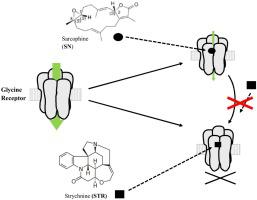NeuroToxicology ( IF 3.4 ) Pub Date : 2020-07-20 , DOI: 10.1016/j.neuro.2020.07.002 Hesham A Saleh 1 , Karim M Raafat 2 , Tarek A Temraz 3 , Nazih Noureldin 1 , Hans-Georg Breitinger 2 , Ulrike Breitinger 2

|
The inhibitory glycine receptor (GlyR) is a key mediator of synaptic signalling in spinal cord, brain stem, and higher centres of the central nervous system. We examined the glycinergic activity of sarcophine (SN), a marine terpenoid known for its various biological activities, and its trans-diol derivative (7S, 8R)-dihydroxy-deepoxysarcophine (DSN). SN was isolated from the Red Sea soft coral Sacrophyton glaucum, DSN was semisynthesized by hydrolysis of the epoxide ring. In cytotoxicity tests against HEK293 cells, SN and DSN had LD50 values of 29.3 ± 3.0 mM and 123.5 ± 13.0 mM, respectively. Both compounds were tested against recombinant human α1 glycine receptors in HEK293 cells using whole-cell recording techniques. Both, SN and DSN were shown for the first time to be inhibitors of recombinant glycine receptors, with KIvalues of 2.1 ± 0.3 μM for SN, and 109 ± 9 μM for DSN. Receptor inhibition was also studied in vivo in a mouse model of strychnine toxicity. Surprisingly, in mouse experiments strychnine inhibition was not augmented by either terpenoid. While DSN had no significant effect on strychnine toxicity, SN even delayed strychnine effects. This could be accounted for by assuming that strychnine and sarcophine derivatives compete for the same binding site on the receptor, so the less toxic sarcophine can prevent strychnine from binding. The combination of modulatory activity and low level of toxicity makes sarcophines attractive structures for novel glycinergic drugs.
中文翻译:

红海软珊瑚Sarcophyton glaucum的Sarcophine和(7S,8R)-dihydroxydeepoxysarcophine作为甘氨酸受体的体外和体内调节剂。
抑制性甘氨酸受体(GlyR)是脊髓,脑干和中枢神经系统中枢的突触信号传导的关键介体。我们检查了鲨鱼碱(SN)(一种因其各种生物学活性而闻名的海洋萜类化合物)及其反式二醇衍生物(7S,8R)-二羟基-深氧肌氨酸(DSN)的甘氨酸活性。SN是从红海软珊瑚Sa草中分离出来的,DSN是通过环氧化物的水解而半合成的。在针对HEK293细胞的细胞毒性测试中,SN和DSN的LD 50值分别为29.3±3.0 mM和123.5±13.0 mM。使用全细胞记录技术,对这两种化合物针对HEK293细胞中的重组人α1甘氨酸受体进行了测试。SN和DSN首次显示是重组甘氨酸受体的抑制剂,SN的K I值为2.1±0.3μM,DSN的K I值为109±9μM。在体内也研究了受体抑制在士的宁中毒的小鼠模型中。出人意料的是,在小鼠实验中,任一种萜类化合物均未增强对士的宁的抑制作用。尽管DSN对士的宁的毒性无明显影响,但SN甚至延缓了士的宁的毒性。这可以通过假设士的宁和芥子碱衍生物竞争受体上的相同结合位点来解释,因此毒性较小的茶碱可以阻止士的宁结合。调节活性和低毒性的结合使肌磷酰胺成为新型甘氨酸药物的诱人结构。











































 京公网安备 11010802027423号
京公网安备 11010802027423号